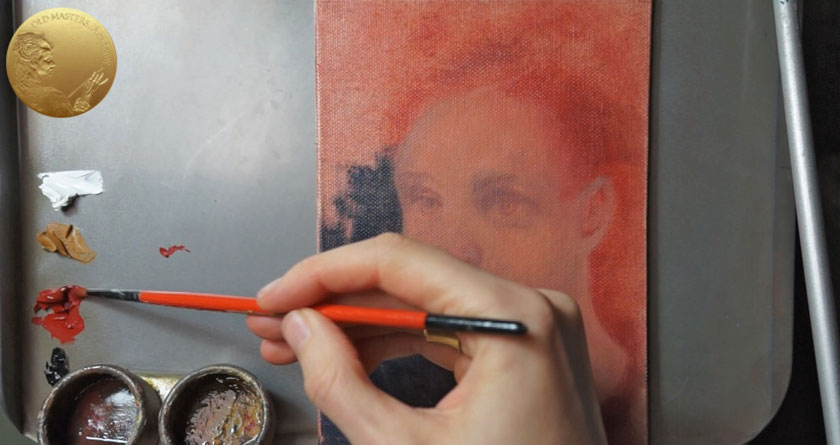Art Lesson 33, Part 4
In this lesson, you will see the step of Finishing a Painting
Learn how to paint like the Old Masters!
Old Masters Academy Online Course
Self-study, self-paced online video courseLifetime membershipOne-time payment: $487Enroll Now!Personal Tutoring online + Online Course
Unlimited tutoring by the Academy teachersLifetime membershipOne-time payment: $997Enroll Now!« Back to the Art Lessons List
Finishing a Painting
Now, when the Color Underpainting is dry, we are going to finish the painting in one go, as we will do it now in this exercise. Alternatively, we could finish it in many sessions, if we are creating a proper composition, rather than just an exercise.
Let’s start with the hair. We sketch out the hair roughly in loose brush strokes with undiluted Venetian Red. We also paint over a Blue-Black background with a Red-Black mix. It’s really optional and if you want, the original background might remain as it is. It does not really matter.

But what matters is the next procedure of the face painting. We mix a skin color by adding Red and Yellow to White. The paint should be dense, so there is no need for any painting mediums. We apply the paint opaquely in the lighted areas and spread it thinly in half-shades.
After that, we ready to work on the facial details. Again, we paint the irises as we already did in previous video lessons – we mix White and Black in different proportions to get from a very dark to a light gray mix. For this detailed work, we use the smallest size of a brush. Then, we proceed with the mouth and nose.
We see that the tone of the skin should be lightened. While our previous skin color layer is still wet, we coat it over with an additional one. We use a soft brush for that and work with it very gently – in this way, it will not remove the lower layer of paint. This upper layer of skin tone brings the volume to the thickness of the surface.
And at the very end, we place reflected lights in the eyes and a few dabs of highlights on the nose and lips.
Here, you see the previous stage of the painting and the result we got at the end, in a very fast wet-on-wet method.




